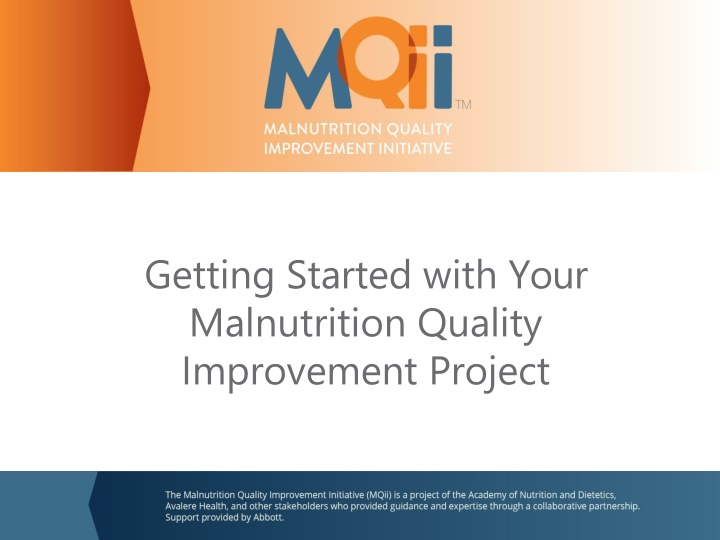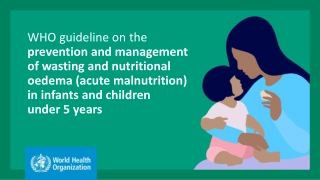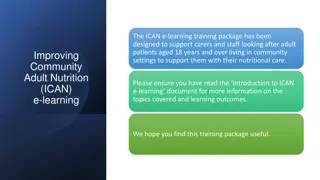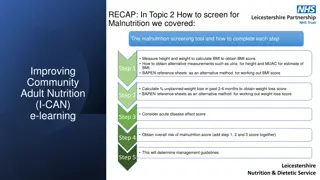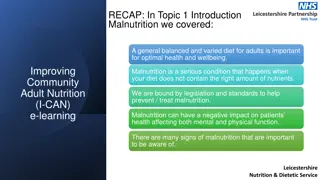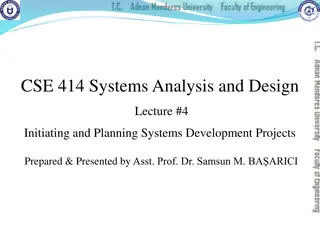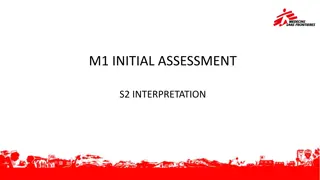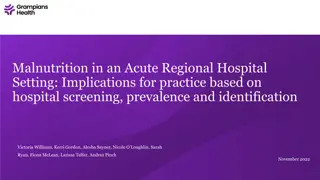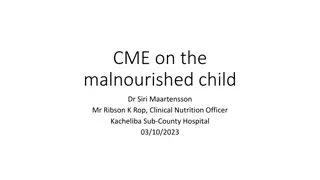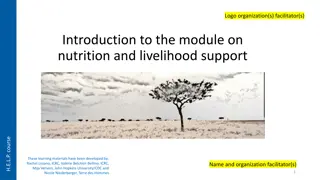Initiating Your Malnutrition Quality Improvement Project
Initiate your malnutrition quality improvement project by assessing facility readiness, assembling the right team, understanding the QI process, mapping clinical workflows, and focusing on quality improvement using the Plan-Do-Study-Act approach. Recommended roles include a hospital leader, dietitian, nurse, physician, executive sponsor, project champion, and IT/Informatics representative. Engage champions for each role in the care team to drive successful implementation and outcomes.
Download Presentation

Please find below an Image/Link to download the presentation.
The content on the website is provided AS IS for your information and personal use only. It may not be sold, licensed, or shared on other websites without obtaining consent from the author.If you encounter any issues during the download, it is possible that the publisher has removed the file from their server.
You are allowed to download the files provided on this website for personal or commercial use, subject to the condition that they are used lawfully. All files are the property of their respective owners.
The content on the website is provided AS IS for your information and personal use only. It may not be sold, licensed, or shared on other websites without obtaining consent from the author.
E N D
Presentation Transcript
Getting Started with Your Malnutrition Quality Improvement Project
Presentation Overview Assess Your Facility s Readiness Assemble Your Team Understand the Process for Malnutrition Quality Improvement (QI) Map Your Clinical Workflow Select Your Quality Improvement Focus Using a Plan-Do-Study-ActApproach to QI 2
Assess Your Facilitys Readiness: Understand How to Support Your Ability to Undertake Malnutrition QI Use the Readiness Questionnaire to evaluate your facility s readiness to undertake malnutrition quality improvement and initial steps to prepare for your project. 3
Assemble Your Team: Recommended Roles and Responsibilities for Your Core Team Member Role Suggestions Est Time Hospital Leader to champion the effort from a leadership perspective, works to maintain executive leadership buy-in Recommend Executive Sponsor and Project Champion establish regular meetings (i.e., monthly) to receive progress updates Recommend Project Champion establish a team of champions (see next slide) and lead weekly huddles throughout this effort to discuss barriers and next steps. It might be useful to hold meetings twice a week. Executive Sponsor 30 mins. per month to review progressand approach 10 - 15 hours per month (depends on QI focus and resources) Dietitian who generates support and buy-in for project by all relevant parties. Leads day-to-day efforts for this initiative. Develops processes for this project at site and spreads enthusiasm across hospital about the effort.Attends all educational webinars, participates in discussion boards and leads Toolkit implementation (e.g., leads clinician training).A nurse and/or physician may serve as a Co-champion. Assist with collecting and analyzing data elements required for eCQMs, length-of-stay, readmissions, and any other necessary data Project Champion Recommend maintaining regular communications with the Project Champion to ensure timely transmission of data IT/Informatics Representative ~40 hours total to build eCQM report 25
Assemble Your Team: Value of Including Champions for Each Role in the Care Team Recommended Value-Add Est Time If the Project Champion is not a dietitian, we recommend engaging a dietitian leader who will champion this effort across dietitians and make sure targeted QI changes are adopted. Dietitian Champion 4 8 hours per month (Depends on QI focus) It is also ideal to include a dietitian staff member on the team in addition to the dietitian project champion Nurses are the first line of defense to identify malnourished patients. They also play a critical role in implementing interventions and discharge planning. It can be useful to have a nurse champion the value of this effort across nursing staff and make sure their nutrition care responsibilities are implemented effectively. Nurse Champion 4 8 hours per month (Depends on QI focus) Physicians play a critical role in implementing interventions, particularly when establishing a diagnosis and support optimal care coordination amongst members of the care team. We recommend securing support from a physician leader who will champion this effort and make sure targeted QI changes are adopted. Physician Champion 4 8 hours per month (Depends on QI focus) 26
Assemble Your Team: Suggested Additional Team Member Recommended Value-Add Est Time A representative from your institution s Quality Improvement Department/Committee should be identified to serve as a liaison responsible for the identification of existing quality improvement tools and resources within your institution to support implementation. Quality Improvement Team Representative 1 hour a month to attend huddles 27
Understand the Process for Malnutrition Quality Improvement Engage Your Project Team and Secure their Commitment Identify and Map Your Workflow and Compare to Recommended Best Practices Complete theAssessment and Decision Tool Use the Output to Select your QI Focus and Intervention Plan Your Implementation and Introduce the Changes
Select Your Malnutrition QI Intervention Use the Nutrition Care Opportunity Assessment Tool to consider where opportunities for improvement exist, based on the results of your clinical workflow mapping You can also use the electronic clinical quality measures (eCQMs) to collect baseline data on your care processes and identify existing gaps in care delivery. 9
Using a PDSA Approach to QI Allows You to Pursue Improvements with Guidance from eCQM Data Prepare for Engagement with Care Teams, Plan for Training o GettingStarted Checklist o Care Assessment & Decision Tool o Malnutrition Clinical Workflow Template o Root Cause Analysis Guide o PDSA Cycle Templates Train Care Teams on New Workflowsor Documentation o Implementation Roadmap o MQii Project Charter Plan Do Act Study Collect Performance Data to Calculate eCQMs oeCQM Specifications Manual oeCQM Performance Calculator oLessons Learned Log Assess eCQM Performance to Identify Areas of Opportunity for Improvement oSustainability Plan Template oLessons Learned Log Each tool includes guidance on how and when your team is recommended to use it to support QI decision-making and/or your QI implementation approach PDSA: Plan-Do-Study-Act; QI:Quality Improvement 10 *Resources referenced can be found on the MQiiwebsiteat: https://malnutritionquality.org/
Plan Do MQii Tools To Support Participants QI Initiatives (1/2) PROJECT MANAGEMENT TOOLS IN THE PLAN & DO STEPS OF THE PDSA CYCLE FOCUS ON SETTING UP YOUR QI INITIATIVE AND PROJECT TEAM Each tool includes guidance on how and when it can be used to support you with managing your QI intervention Getting Started Checklist MalnutritionClinical WorkflowTemplate CareAssessment& DecisionTool ImplementationRoadmap Recommendsactions foryour implementation period, including expected outcomes andsuggestedtiming Outlines critical steps for beginning a malnutrition QI project Allows you to map your current workflow and compare it to the recommended best practiceworkflow Guides your team s understandingof the current state of malnutritioncare RootCauseAnalysis Guide PDSACycle Templates MQii ProjectCharter* Planningtoolto be completed with your team as you work through the Implementation Roadmap This will facilitate and allow youandyourteam to drill down to the root cause and find optimal solutions After you assess your progress the PDSA cycle will helpyouprepareand take anynext steps Plan Resources Do Resources QI:QualityImprovement 11 *Tools referenced can be found on the MQiiwebsiteat: http://www.MQii.Today
Study Act MQii Tools To Support Participants QI Initiatives PROJECT MANAGEMENT TOOLS IN THE STUDY & ACT STEPS OF THE PDSA CYCLE FOCUS ON IMPLEMENTATION, COLLECTING AND ANALYZING DATA Each tool includes guidance on how and when it can be used to support you with managing your QI intervention eCQMSpecifications Manual SustainabilityPlan Template* LessonsLearnedLog* Provides a template for documenting the lessons learnedoverthecourse of yourQI implementation Provides you with guidance for how to implement the four malnutritioneCQMs Guides you with development of a plan for short- and long- term strategies for sustaining improvements eCQMPerformance Calculator* LessonsLearnedLog* Allows you to use those lessons logged during implementation to extract insights and identify potential modifications that may be made to yourproject Allows you to use your extracted EHR data to calculateyourhospital s eCQM performance Study Resources Act Resources QI:QualityImprovement 12 *Tools referenced can be found on the MQiiwebsiteat: http://www.MQii.Today
Data Collection Will be Critical to Implementation Engage Your ITTeam and Secure their Commitment Identify and Map Data Elements & Build eCQM report Run Report and Evaluate Performance Use the Report to Measure Progress Refine the Report as Needed toAlign with Your MQii Goals
